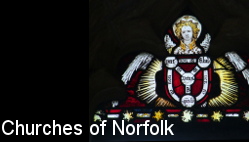
home I index I latest I glossary I introductions I e-mail I about this site
All Saints, Little Melton
Follow these journeys as they happen on X/twitter.
All Saints, Little Melton The village of Little Melton sits on the outskirts of the city of Norwich, separated from it by the four lanes of the A47. It is much larger than neighbouring Great Melton, and sitting as it does between Norwich and Hethersett I suppose it would not be untrue to call it outer suburbia. But the setting of this church is so intensely rural that I cannot bring myself to do so. It's a small church, and it is set in a relatively small churchyard overbowered by trees, like a secret among the barley fields. Yet despite its size, All Saints has aisles to north and south, with Y-tracery in their windows and also in the tower.This tracery becomes reticulated in the east window, so the overall effect on approaching the church is that this is a building entirely of the early 14th Century, most likely rebuilt in a single campaign from west to east. The high gables to nave and chancel show that it was once thatched. You step into the church through the south porch, into a space pleasingly harmonious space full of light. The only coloured glass is in the east window of the south aisle, St Francis preaching to the birds by Paul Jefferies for King & Son, 1968. Much of the light comes through the great Perpendicular west window, the only interloper here. It can be dated by a 1454 bequest from Richard Manger, who left 5 marks to new glass window in tower. The roofs and furnishings came in the 1896 restoration, but much of interest has survived, most notably a series of 14th Century wall paintings that date from when the church was relatively new. The most memorable is a scene known as the Warning Against Gossip. This shows two women with their rosaries sitting on a bench, but instead of praying they are have quiet conversation. A devil stands behind each of them, pushing them together and writing down what they say, to be used as evidence against them. It's a mark of late medieval misogyny that the culprits in this popular scene in wall paintings of the time are always women. Either side of the east window, Gabriel and the Blessed Virgin Mary form an Annunciation scene, Mary holding her hand to her heart as she receives the Holy Spirit in the form of a dove. Another less clear painting above the former north doorway is the lower half of a St Christopher. There are a number of other survivals, one of which is older than the church. This is the 13th Century Purbeck marble font, a large example of this popular style found so frequently in East Anglia up rivers from the coast. It's surmounted by a splendid painted 17th Century dome of a font cover. The 15th Century rood screen is in good condition, although no painted figures survive on its dado panels. Intriguingly, the communion rails and the pulpit have parts of another screen built into them. Was there a parclose screen in one or both of the aisles, perhaps, or did the woodwork come from the roodloft? Beside the screen on the north side of the chancel arch is a beautiful piscina that marks the place where a side altar would have stood in the nave. Up in the chancel, an unusual double piscina and what remains of the sedilia date from the rebuilding of the church. On the opposite wall of the chancel is the memorial to Richard and Bridget Scottowe. He died in 1655, when this memorial would have been erected. However, she survived him by 63 years and was added to it when she died in 1718, a most unusually late date to find on a memorial in this style. Underneath it are four memorials to other members of the Scottowe family in engraved copper. As Pevsner points out, the Scottowes were silversmiths. A mark that the Anglican revival of the 19th Century came relatively late to some parts of Norfolk is that at the time of the 1851 Census of Religious Worship, the chancel here was still being used as the village school. However, as the rector John Charles Barkley noted in his return to the census, in consequence of adverse circumstances, the school has been discontinued during the past year. It will be re-established during the coming summer - but in the winter the Church is too cold for the children, and the Incumbent is unable to build or purchase a School House - having no one to share with him the expense. Simon Knott, February 2024 Follow these journeys as they happen on X/twitter. |
|
||||||||||||||||||||||||||||||||||||||||||||||||||||||
home I index I latest I introductions I e-mail I about
this site I glossary
Norwich I ruined churches I desktop backgrounds I round tower churches
links I small
print I www.simonknott.co.uk I www.suffolkchurches.co.uk